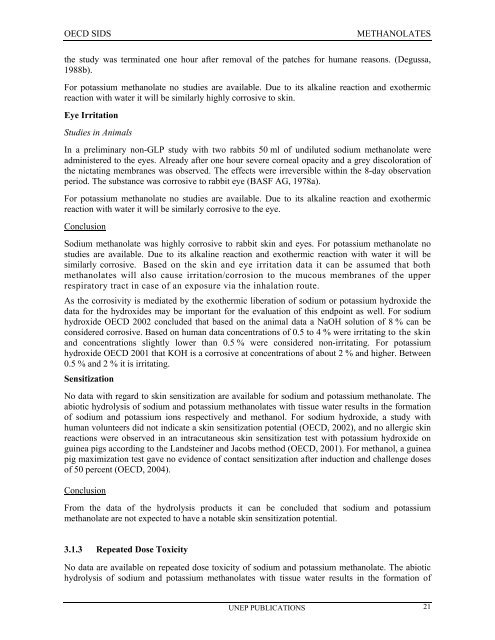Sodium methanolate - ipcs inchem
Sodium methanolate - ipcs inchem
Sodium methanolate - ipcs inchem
You also want an ePaper? Increase the reach of your titles
YUMPU automatically turns print PDFs into web optimized ePapers that Google loves.
OECD SIDS<br />
METHANOLATES<br />
the study was terminated one hour after removal of the patches for humane reasons. (Degussa,<br />
1988b).<br />
For potassium <strong>methanolate</strong> no studies are available. Due to its alkaline reaction and exothermic<br />
reaction with water it will be similarly highly corrosive to skin.<br />
Eye Irritation<br />
Studies in Animals<br />
In a preliminary non-GLP study with two rabbits 50 ml of undiluted sodium <strong>methanolate</strong> were<br />
administered to the eyes. Already after one hour severe corneal opacity and a grey discoloration of<br />
the nictating membranes was observed. The effects were irreversible within the 8-day observation<br />
period. The substance was corrosive to rabbit eye (BASF AG, 1978a).<br />
For potassium <strong>methanolate</strong> no studies are available. Due to its alkaline reaction and exothermic<br />
reaction with water it will be similarly corrosive to the eye.<br />
Conclusion<br />
<strong>Sodium</strong> <strong>methanolate</strong> was highly corrosive to rabbit skin and eyes. For potassium <strong>methanolate</strong> no<br />
studies are available. Due to its alkaline reaction and exothermic reaction with water it will be<br />
similarly corrosive. Based on the skin and eye irritation data it can be assumed that both<br />
<strong>methanolate</strong>s will also cause irritation/corrosion to the mucous membranes of the upper<br />
respiratory tract in case of an exposure via the inhalation route.<br />
As the corrosivity is mediated by the exothermic liberation of sodium or potassium hydroxide the<br />
data for the hydroxides may be important for the evaluation of this endpoint as well. For sodium<br />
hydroxide OECD 2002 concluded that based on the animal data a NaOH solution of 8 % can be<br />
considered corrosive. Based on human data concentrations of 0.5 to 4 % were irritating to the skin<br />
and concentrations slightly lower than 0.5 % were considered non-irritating. For potassium<br />
hydroxide OECD 2001 that KOH is a corrosive at concentrations of about 2 % and higher. Between<br />
0.5 % and 2 % it is irritating.<br />
Sensitization<br />
No data with regard to skin sensitization are available for sodium and potassium <strong>methanolate</strong>. The<br />
abiotic hydrolysis of sodium and potassium <strong>methanolate</strong>s with tissue water results in the formation<br />
of sodium and potassium ions respectively and methanol. For sodium hydroxide, a study with<br />
human volunteers did not indicate a skin sensitization potential (OECD, 2002), and no allergic skin<br />
reactions were observed in an intracutaneous skin sensitization test with potassium hydroxide on<br />
guinea pigs according to the Landsteiner and Jacobs method (OECD, 2001). For methanol, a guinea<br />
pig maximization test gave no evidence of contact sensitization after induction and challenge doses<br />
of 50 percent (OECD, 2004).<br />
Conclusion<br />
From the data of the hydrolysis products it can be concluded that sodium and potassium<br />
<strong>methanolate</strong> are not expected to have a notable skin sensitization potential.<br />
3.1.3 Repeated Dose Toxicity<br />
No data are available on repeated dose toxicity of sodium and potassium <strong>methanolate</strong>. The abiotic<br />
hydrolysis of sodium and potassium <strong>methanolate</strong>s with tissue water results in the formation of<br />
UNEP PUBLICATIONS 21
















